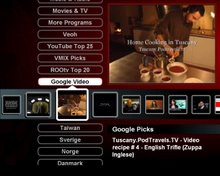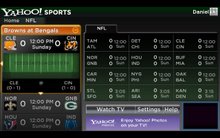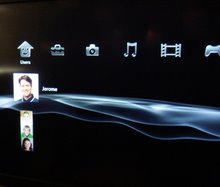Behind the scene: I expect many high-end TV developers to closely consider the new Intel TV chip. Has any lack of clear leadership or innovation from the traditional TV chip suppliers left them vulnerable to market share loss? Or do they know something about the home TV user that new entrants have yet to grasp?
Solution: There are many competing technical and business approaches in support of digital convergence for the TV. Introducing a cost-effective Intel TV chip is clearly some kind of milestone. However, given Intel’s experience with Viiv, it should be aware that there are still critical and necessary development steps ahead: developing infrastructure, partners, and customers, and most importantly communicating the value to end users – these remain paramount and time-consuming steps to be undertaken.
Intel provided more information last week at the San Francisco Intel Developer Form (IDF) about their efforts to bring the software advantages of the x86 architecture to the living room TV. Prior approaches branded as ViiV had little success and partially relied on Microsoft Media Center technology. The new approach is very different and based on incorporating an x86 ‘Pentium M’ processor into a TV System-on-a Chip (SoC).
The x86 CPU architecture has a software advantage because of its use in the PC. This has lead to a long history of extensive and complex software being developed for the PC, which is frequently not made available (“re-targeted” as the technical types say…) for other CPU architectures. A good example of this is Adobe’s Flash, that essential plug-in to the PC browser. For non x86 CPU-based devices, Flash is either not available or available several generations removed from the current offering.
As digital convergence proceeds, consumer appliances are required to support software applications, which have thus far been the domain of the PC. It has proven difficult for traditional TV SoC suppliers, who do not rely on an x86 CPU core, to develop software to enable a TV to perform PC-like tasks, such as web browsing.
Intel documentation provides a block diagram of their CE3100 TV SoC family. Coupled with “aggressive” pricing, Intel is on course to have a significant influence on the initially high-end TV and Set Top Box (STB) markets. Using the CE3100 family, devices such as the Apple TV, which currently uses a PC-like architecture, can carry a lower hardware component cost. In fact, the CE3100’s support for processing a broadcast digital Transport Stream (TS) enables support for features currently beyond Apple TV.

As well as building a new range of TV chips, Intel will provide much of the software infrastructure supporting a CE3100-based networked TV. For this, they have to combine networking and web processing software with traditional TV software (what the engineers call dual software stack operation). Intel press releases indicate that they have worked with Futarque on this task. Interestingly, Futarque also collaborated with AMD on active-TV technology STBs.
No matter how enthusiastic technologists and business analysts are about the potential of TV convergence, it s is not clear how much technology the TV user really wants. Maybe a 3D UI with Flash animation is not desired by many? Maybe something much simpler, such as the very successful MHEG5 deployment in Europe, will continue to satisfy most TV users? That said, MHEG5 may not be left behind: there are companies working to add Ethernet and social network support for simpler MHEG5 TVs. If the CE3100-derived TV remains open (like the PC browser, for example) then it will gain the attention of many software developers, who will experiment and find hybrid software combinations that meet with TV user approval. However, if TV OEMs close their TVs -- like the Apple TV -- to “monetize” all convergence features, then the uptake will be much slower.
Increasingly, efforts such as MHP, OCAP or tru2way appear dated before they even have their day-of-success in the market. Their inability to deliver acceptable software solutions has left the market open to the CE3100, which draws upon software with a proven PC history.
Both the Intel Viiv and AMD Live!-branded projects, promoted as supporting digital convergence, met with little success. Interestingly, as Intel finds a new way forward via an x86 based TV SoC, AMD announces it will sell to Broadcom the TV SoC business it acquired with the ATI merger. AMD’s analysis of digital convergence would appear quite different from Intel’s
Technically Speaking
Requests by the networked TV to access an Internet webpage or widget are sent to the home router; and then on via the router’s broadband connection to the webpage or widget server. A TV must process the webpage or widget when it arrives. This requires complex software, which has traditionally been incorporated into the PC’s browser. A TV based on the Intel CE3100 has an advantage when stepping-up to perform these complex software tasks.
The active-TV technology approach relies on the router handing off much of the software task to a proxy in the form of a networked home PC: It enables a TV SoC not equipped with an x86 processor to access a PC’s software processing advantage. The TV’s request is first processed by the PC assisting the TV, and then simplified data is sent by the PC proxy to the TV for display. Some TV developers may prefer this approach as it reduces the prospect of TV obsolesce. The TV “borrows” the PC’s browser in support of its Internet access. This reduces the task of maintaining the TV’s browser software. TV purchasers expect a 10 or greater-year lifespan from their TV, as they would like to avoid the 3 year replacement cycle of traditional PC ownership. Conversely, TV manufacturers likely feel differently and would like to shorten this lifecycle.
More than Networking
Pioneer, Sharp, Samsung, Panasonic and others have introduced TVs with network support. Sometimes they are described as DLNA- or UPnP-enabled TVs. These TVs can access photos, music or video stored on a PC, which are also connected to the home network. Partly due to lack of simplified standards, these TVs are often poorly equipped to access Internet broadcast video directly.
Using an approach similar to active-TV technology, these TVs can use PC assistance to gain access to Internet video. MediaMall, a supplier of active- TV technology components, has announced a Beta version of its PlayOn software. This software runs on a PC that then acts as a proxy for the TV trying to access broadband-delivered video. Typically, a PC is used to access video from Hulu, YouTube or the like. But by using PlayOn, a PC can forward the video to any TV within the home network. The PlayOn software greatly extends the usefulness of a “simple” networked TV. A user can completely control video search and viewing using the TV IR remote, without requiring any contact with the PC assisting the TV.
Active-TV technology is more advanced than PlayOn, as it enables the PC to serve as a proxy for the TV accessing TV-formatted web pages that likely contain Adobe Flash. However, using active-TV technology requires a TV with middleware support beyond DLNA-UPnP. The simpler PlayOn software works with existing DLNA or UPnP-enabled TVs. Similar DLNA-TV supporting software from TVersity has been widely used for much the same task (2 Million downloads). TVersity is currently a more mature product, with reviewers indicating that, “at the moment PlayOn’s list of supported devices is much smaller than TVersity’s”. However, PlayOn is at the Beta-release stage. Their initial support for only online services indicates a focus on premium video services (such as Hulu), versus local PC-stored media.
Don’t forget the game platforms
For some time now, game platforms such as the Xbox, Playsation and Wii have included network support. This has enabled them to offer limited access to Internet broadcast video. Powerful as these game platforms are, they are not equipped to access the Internet with a browser as up-to-date as those used by the PC. This restricts their use for TV-web browsing.
Interestingly, in an effort to extend its audience reach, the BBC recently introduced a website tailored for the limited Wii browser. This enables access to BBC’s iPlayer catch-up video service. But to deal with current Wii limitations, the BBC must serve-up the video in the older Flash 7 video format, rather than the more efficient H.264.
We can expect to see versions of TVesity and PlayOn which further extend the types and variety of game platforms able to access video. These will no doubt rely on a PC assisted approach. Unlike the BBC, the PlayOn team can’t change the format of the served-up video, but they can use a PC to massage the video into a format digestible by simpler devices. The PlayOn website already indicates there will shortly be an enhanced version of PlayOn for the Wii.
Also relating to game platform developments, BroadQ had been working on PC-assisted software for the Playstation 2 (PS2). Recent developments indicate they have shifted to a method wherein the PS2 can access Internet video directly over a network connection – no PC assistance is required. BroadQ’s PS2 software is developed in Lua , much like some Sony PSP applications. Reports indicate the Qtv-branded software can directly play Internet video in FLV, H.264 and DivX formats. To simplify the Qtv PS2 software, the system relies on an Internet-accessed BroadQ server. This should prove interesting competition to the Wii when used to similarly access internet broadcast video.
What next
There are other platforms that avoid using networked PC-assistance, by supporting only simplified browsing -- such as the Syabas Digital Media Player box. Their DMP (also know as the Popcorn Hour A-100) supports most of the CE-HMTL format. Several sites are available for use with the DMP. The sites are accessed via a Media Service Portal (MSP). Maybe it would be better to call them portal plug-ins rather than websites.
Observers of digital convergence can only be impressed by the relentless efforts applied to bring Internet technology or interactivity to the TV. The CE3100 TV SoC is Intel’s best effort yet to make the x86 CPU architecture affordable for deployment within new TVs. On the one hand, it leverages a software installed base that includes support for Adobe Flash and other vital video entertainment software building blocks; on the other, it requires a new set of tools (and perhaps complexity) traditional TV manufacturers are not familiar with, as well as somewhat higher initial costs and perhaps the risk that consumers are not ready to embrace ‘full-on’ Internet-broadcast TV. Moreover, it is not the only technology or approach available, and some of the incremental approaches (with or without ‘borrowing’ PC browser assistance), may be just as valid, at least in the short term.
We will have to wait and see how the roll-out of the CE3100 TV SoC affects the evolution of the TV convergence market. To be sure, there will be business pressures to use it in only closed system. In view of competing and perhaps equally compelling approaches, however, I suggest Intel will gain the most traction in the market if it offers an ‘open’ platform for any software developer wishing to reach the TV screen.
Feedback, corrections and comments welcome. Contact me for more information or support with active-TV technology development.
Daniel Mann











6 comments:
Hello,
I keep coming to this website[url=http://www.weightrapidloss.com/lose-10-pounds-in-2-weeks-quick-weight-loss-tips].[/url]Plenty of useful information on active-tv.blogspot.com. Frankly speaking we really do not pay attention towards our health. In plain english I must warn you that, you are not serious about your health. Research indicates that nearly 50% of all USA grownups are either chubby or weighty[url=http://www.weightrapidloss.com/lose-10-pounds-in-2-weeks-quick-weight-loss-tips].[/url] Therefore if you're one of these individuals, you're not alone. Its true that we all can't be like Brad Pitt, Angelina Jolie, Megan Fox, and have sexy and perfect six pack abs. Now next question is how you can achive quick weight loss? Quick weight loss can be achived with little effort. If you improve some of your daily diet habbits then, its like piece of cake to quickly lose weight.
About me: I am webmaster of [url=http://www.weightrapidloss.com/lose-10-pounds-in-2-weeks-quick-weight-loss-tips]Quick weight loss tips[/url]. I am also mentor who can help you lose weight quickly. If you do not want to go under hard training program than you may also try [url=http://www.weightrapidloss.com/acai-berry-for-quick-weight-loss]Acai Berry[/url] or [url=http://www.weightrapidloss.com/colon-cleanse-for-weight-loss]Colon Cleansing[/url] for effective weight loss.
What good question
I join. I agree with told all above. Let's discuss this question. Here or in PM.
This idea is perfect because we need different ideas x86 is one of the best ideas I've listened, I hope that it works so well.
Excellent post dear blogger, I hope you can add even more about this issue, most of the blogger are doing the same work, being explicative and informative , and you know what? I liked what you wrote about it.
23jj
If you always write interesting, I will be your regular reader.
Post a Comment